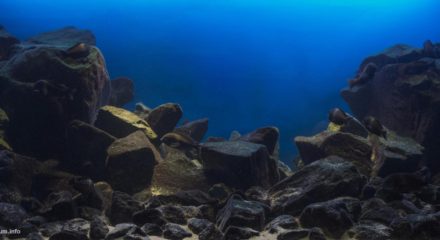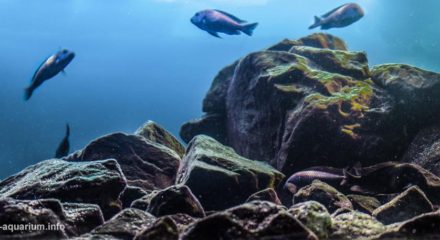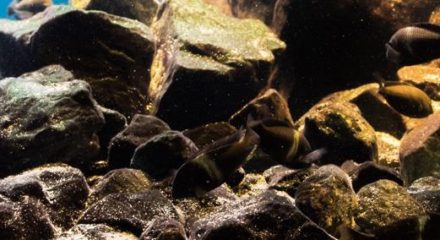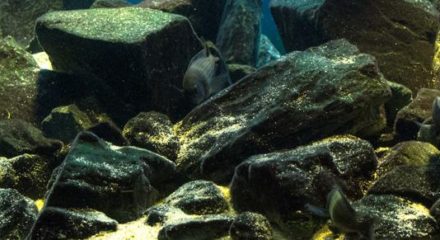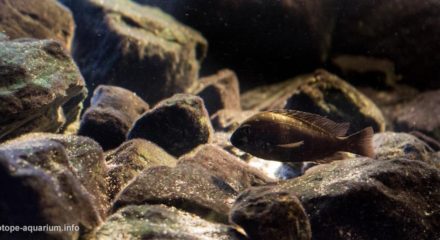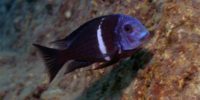Kigoma area, a rocky sediment rich habitat, Lake Tanganyika, Africa
8th place in Biotope Aquarium Design Contest 2016
![]() Turkey. Uğur Ruşen Doğan
Turkey. Uğur Ruşen Doğan
Aquarium Volume: 458 L
Fish and invertebrates: Tropheus Duboisi Maswa
Plants list: None
Biotope description: Tanganyika is the largest rift lake in Africa and the second largest lake by volume in the world. It is the deepest lake in Africa and holds the greatest volume of fresh water, accounting for 18% of the world’s available fresh water. Tanganyika’s only outlet is the Lukuga River, which flows into the Congo River. As a result of having just one outlet, this rift lake has a particularly high mineral content. This is because most of the salts that flow into it don’t leave, but rather get left behind as the water evaporates. 20 million years ago in East Africa rift valley was born when the basalt layer from Archean and Proterozoic age broke down. These huge basalt blocks did broke into smaller pieces with the help of tectonic motions and look like demolished buildings. There are many different regions like those in Lake Tanganyika and Kigoma area is one of these. Kigoma Region resides in the northwestern corner of Tanzania, on the eastern shore of Lake Tanganyika. The region lies at about 5° south and 30° east of Greenwich. The shorelinesof Kigoma areas have got rocky habitats.You can see in this region mostly lava rocks and melted rocks together and they are sharp and rough.There are many cave networks that host lots of fish species. Top of these rocks are sediment free and algae rich. Thick layers of algae can be observed in most of the area. Because of food abundance, competition is mostly territorial, and those fish species which are strong enough to defend their terrority survive. There are many cichlid species in this region. Also Tropheus duboisi Maswa lives in Kigoma area and competes for terrorities around the rocky areas. They feed on the algae on the rocks. T. duboisi lives from 8 to 25 meters depth, but is rarely seen deeper than 8 meters. The cichlids living in Kigoma: Neolamprologus species like leleupi, brichardi, savoryi, splendens, and pulcher (4-20 meters), Altolamprologus calvus, A. compressiceps, and A. fasciatus (rocky habitat 30 – 100 cm). Also the following genera Lepidiolamprologus, Chalinochromis, Julidochromis (J. marlieri, transcriptus, and dickfeldi) and Ophthalmotilapia (O. boops) are found. Water Parameters of Kigoma: 24-28° C, 502 µS, GH 9, KH 28,5, pH 8,5-9,0, NH4 <0,05 mg/l, NO2 0,05 mg/l, NO3 <0,5 mg/l, PO4 <0,02 mg/l, Fe 0,05-0,1 mg/l.
Fish and invertebrates: Tropheus Duboisi Maswa
Plants list: None
Biotope description: Tanganyika is the largest rift lake in Africa and the second largest lake by volume in the world. It is the deepest lake in Africa and holds the greatest volume of fresh water, accounting for 18% of the world’s available fresh water. Tanganyika’s only outlet is the Lukuga River, which flows into the Congo River. As a result of having just one outlet, this rift lake has a particularly high mineral content. This is because most of the salts that flow into it don’t leave, but rather get left behind as the water evaporates. 20 million years ago in East Africa rift valley was born when the basalt layer from Archean and Proterozoic age broke down. These huge basalt blocks did broke into smaller pieces with the help of tectonic motions and look like demolished buildings. There are many different regions like those in Lake Tanganyika and Kigoma area is one of these. Kigoma Region resides in the northwestern corner of Tanzania, on the eastern shore of Lake Tanganyika. The region lies at about 5° south and 30° east of Greenwich. The shorelinesof Kigoma areas have got rocky habitats.You can see in this region mostly lava rocks and melted rocks together and they are sharp and rough.There are many cave networks that host lots of fish species. Top of these rocks are sediment free and algae rich. Thick layers of algae can be observed in most of the area. Because of food abundance, competition is mostly territorial, and those fish species which are strong enough to defend their terrority survive. There are many cichlid species in this region. Also Tropheus duboisi Maswa lives in Kigoma area and competes for terrorities around the rocky areas. They feed on the algae on the rocks. T. duboisi lives from 8 to 25 meters depth, but is rarely seen deeper than 8 meters. The cichlids living in Kigoma: Neolamprologus species like leleupi, brichardi, savoryi, splendens, and pulcher (4-20 meters), Altolamprologus calvus, A. compressiceps, and A. fasciatus (rocky habitat 30 – 100 cm). Also the following genera Lepidiolamprologus, Chalinochromis, Julidochromis (J. marlieri, transcriptus, and dickfeldi) and Ophthalmotilapia (O. boops) are found. Water Parameters of Kigoma: 24-28° C, 502 µS, GH 9, KH 28,5, pH 8,5-9,0, NH4 <0,05 mg/l, NO2 0,05 mg/l, NO3 <0,5 mg/l, PO4 <0,02 mg/l, Fe 0,05-0,1 mg/l.
Photo Gallery
Comments of the members of the jury of Biotope Aquarium Design Contest 2016

It is a very attractive and natural looking representation of a Tanganyika biotope. Also correct setup of the rocks for these fishes. Tropheus are awesome, one of my favourite fish.

Amazing hardscape – stones are placed in a very natural way. Also, probably the best example of how such a natural layout helps to understand the colors of fishes – can you see how good these Tropheus are camouflaged on such a substrate? Dark body with one yellowish stripe blends very well with light patches casted on stones by waves on the water surface.

The name of this layout could be “Tropheus Paradise”. Natural scene with great depth sensation, I liked the infinite blue background. The layout of rocks is awesome.

It is another aquarium with cichlids from African rift lakes, when looking at it there comes a doubt: maybe it was taken in nature? Bravo, great job!
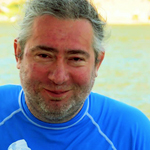
A wonderful natural use of rocks and the Tropheus will be very at home. On the other hand duboisi MASWA cannot be found in Kigoma area but. at Kigoma we have the white band duboisi while at Maswa to Halembe we have variation on yellow bands. With your description with fish living in Kigoma it is not correct that leleupi, splendens, calvus, transcriptus, dickfeldi or boops are found in that part of the lake.

